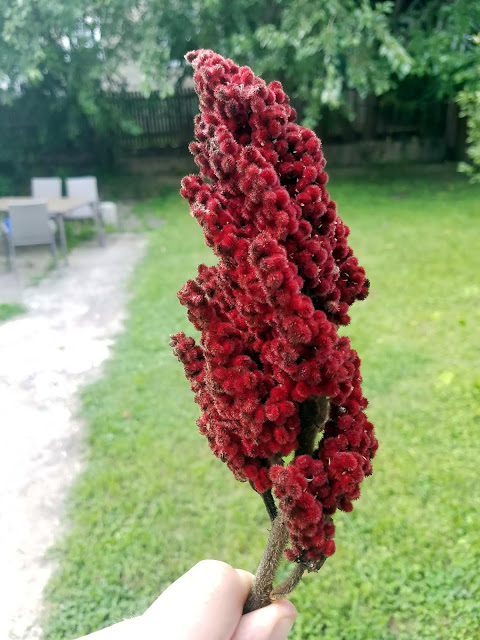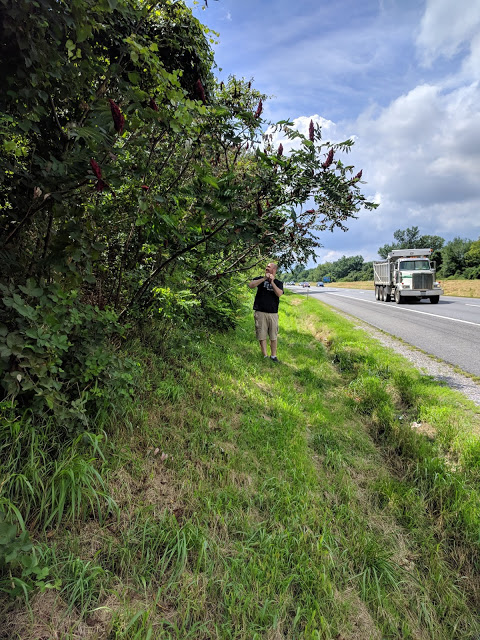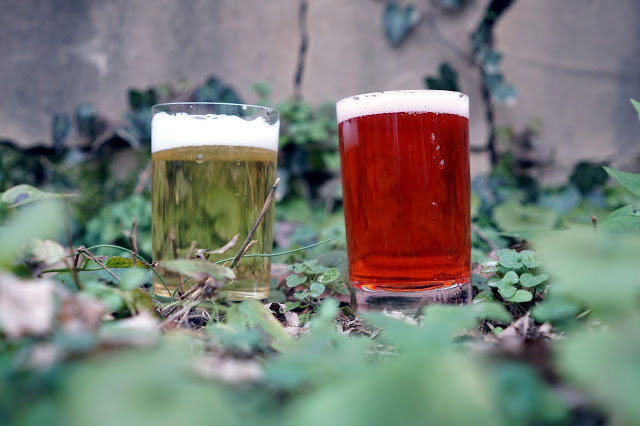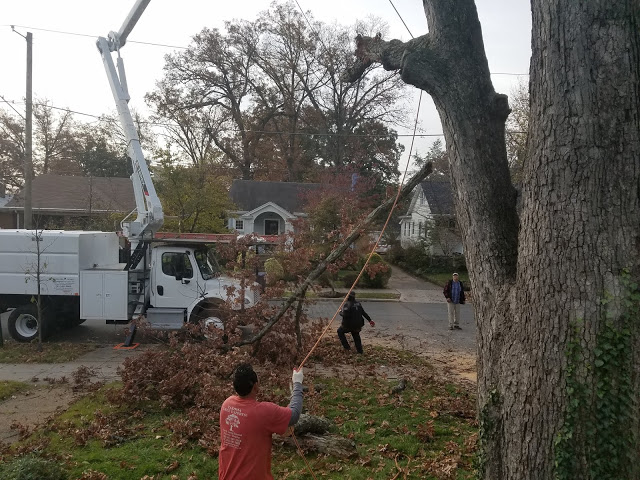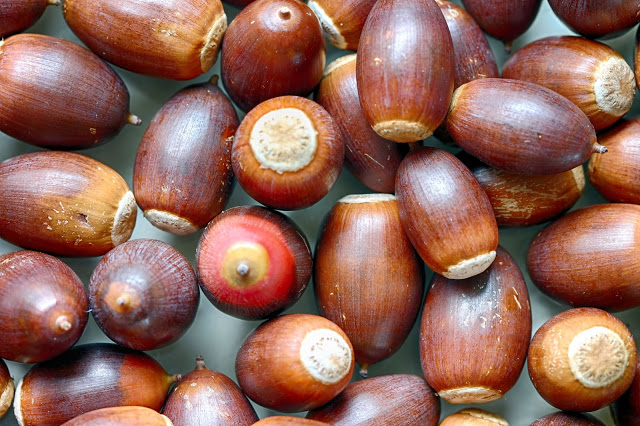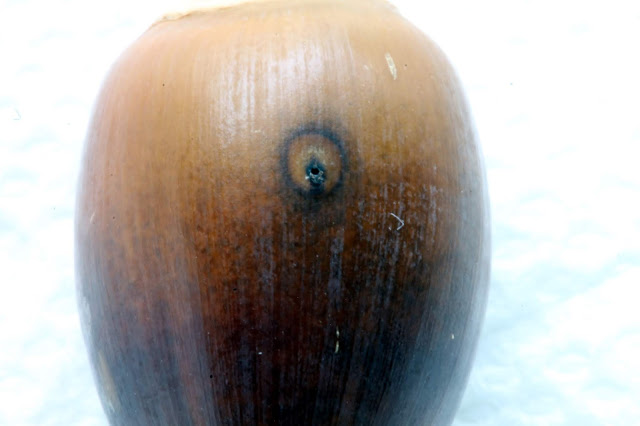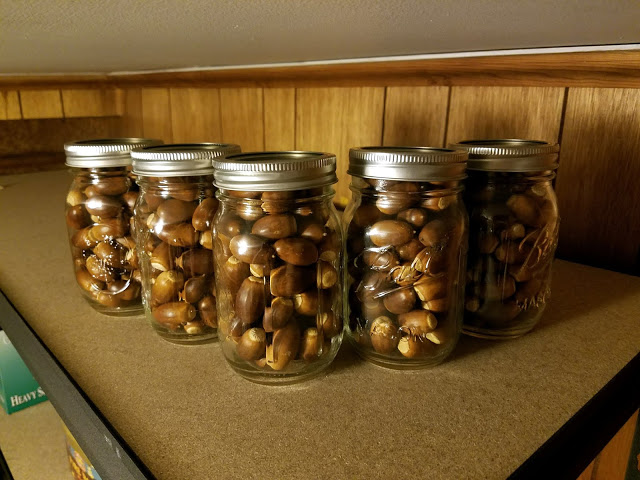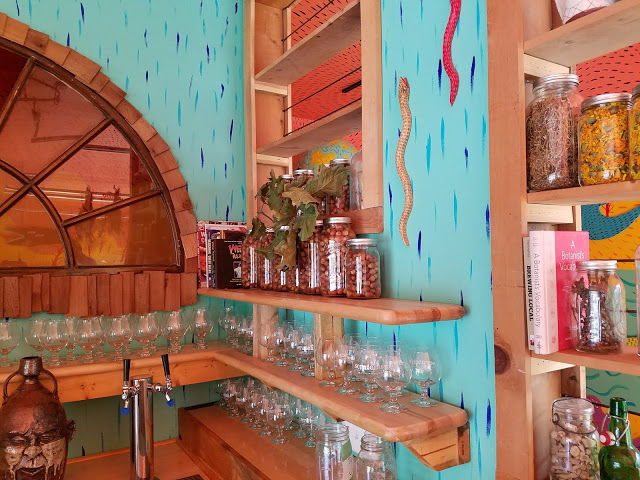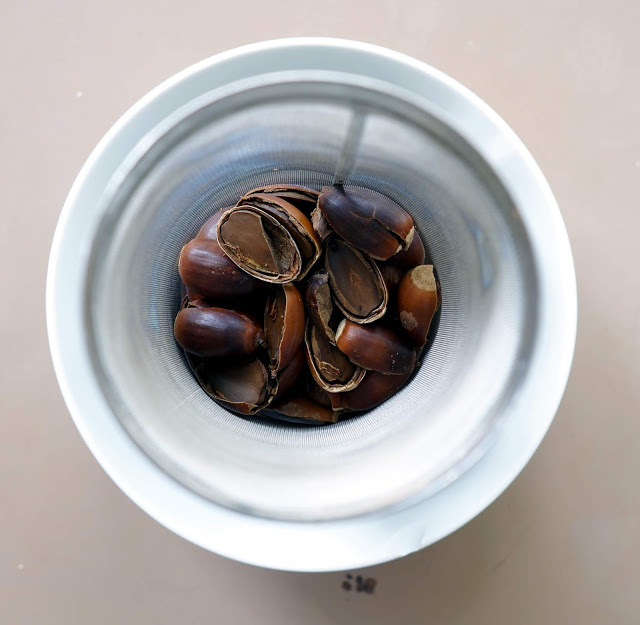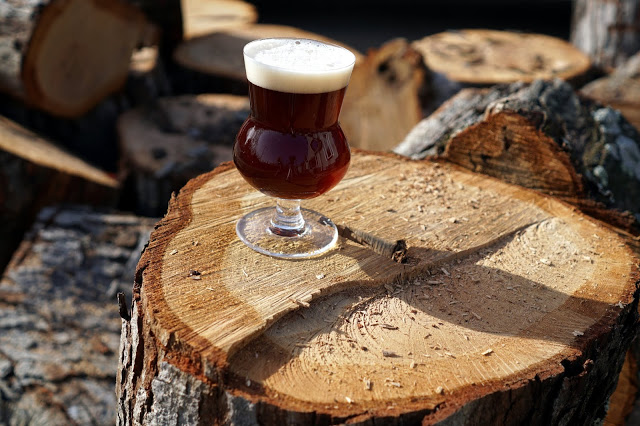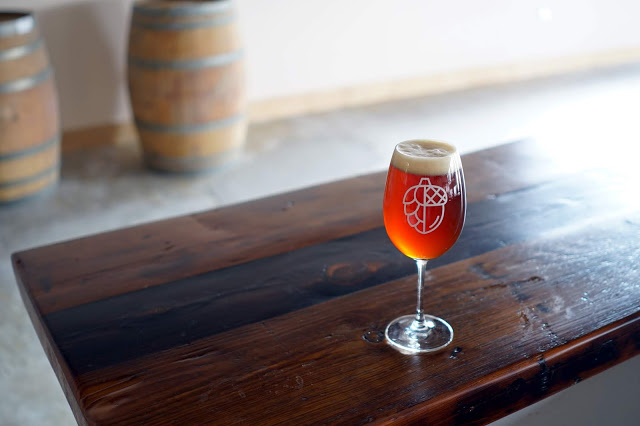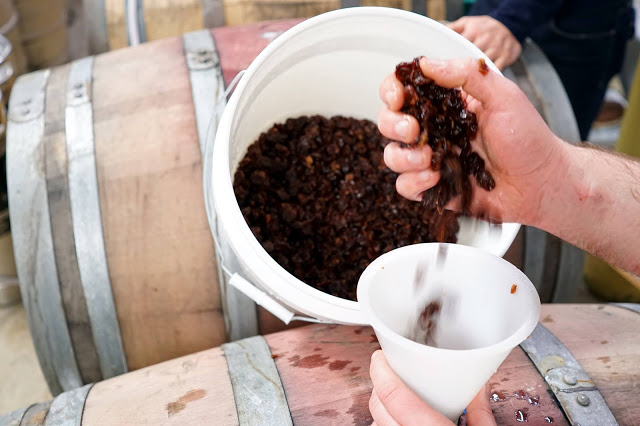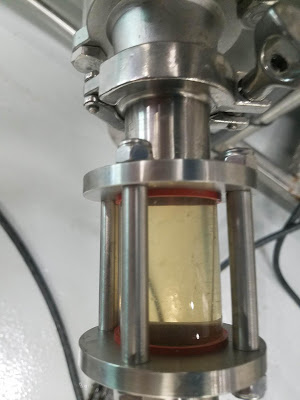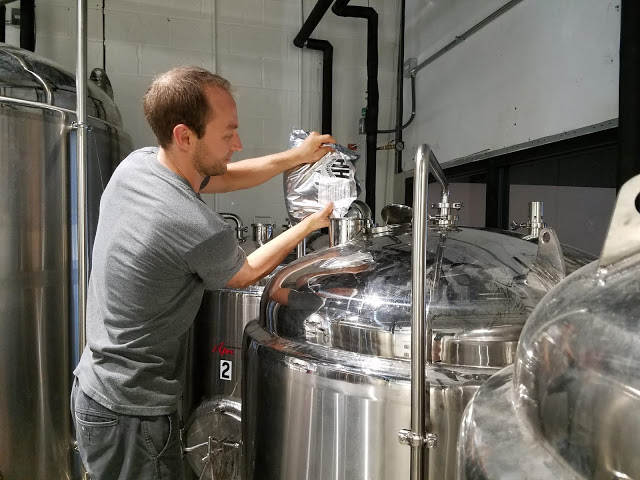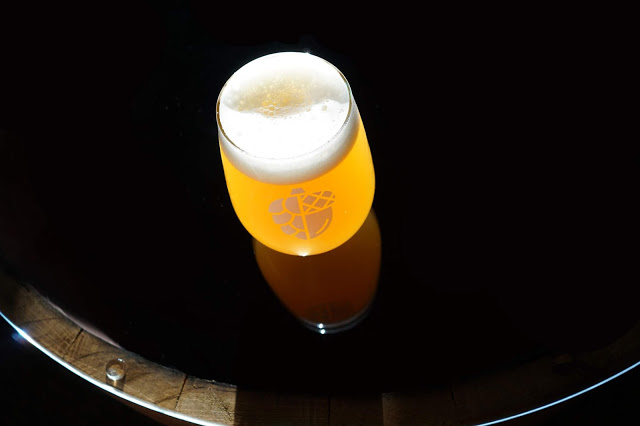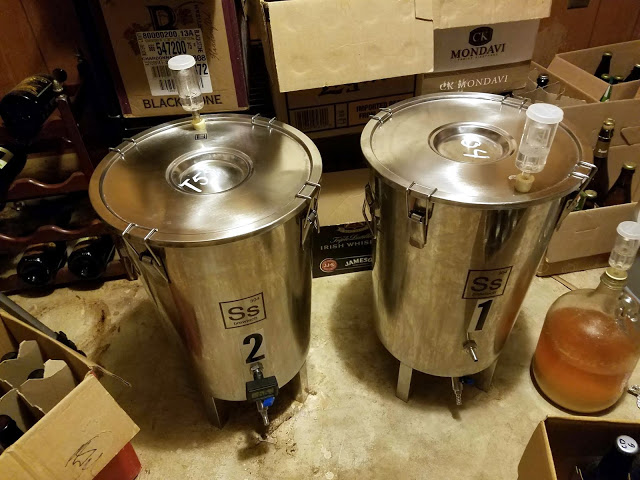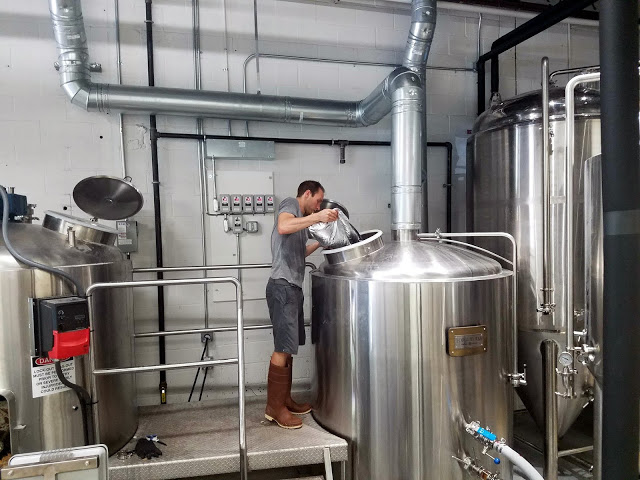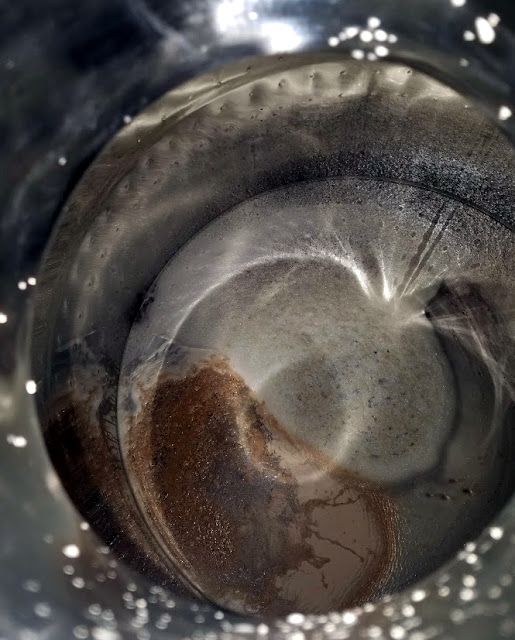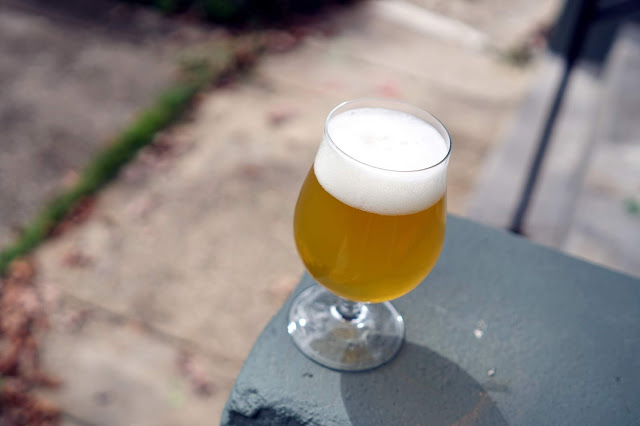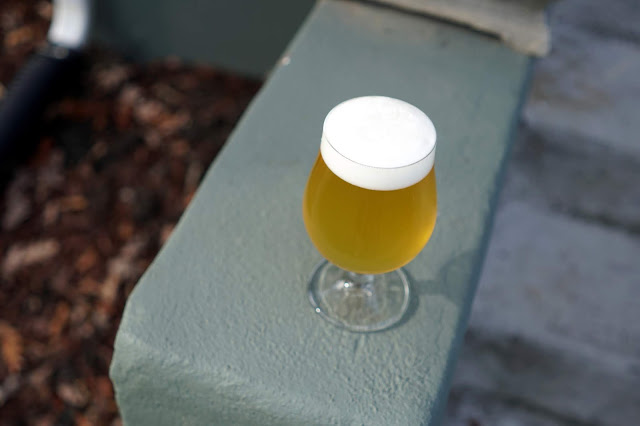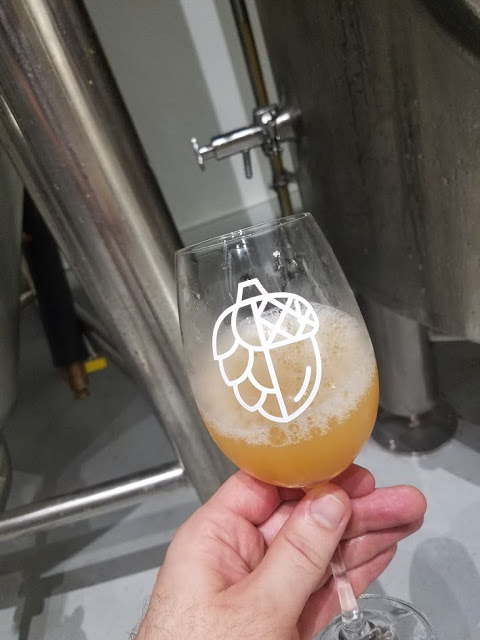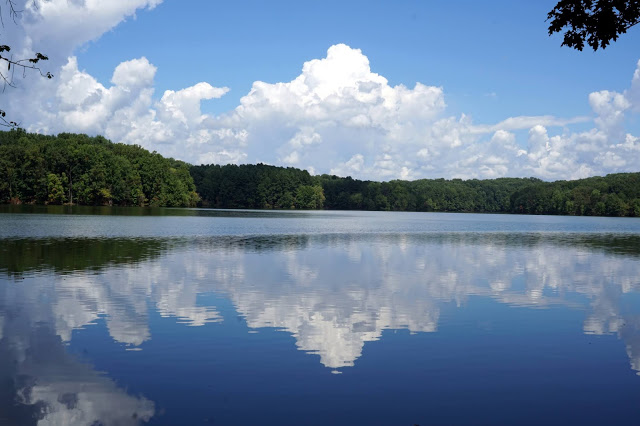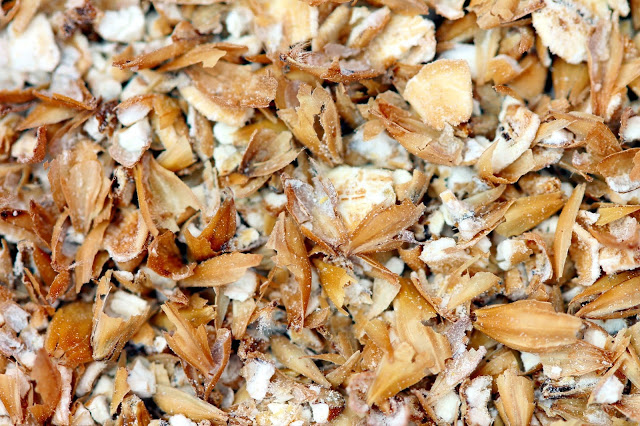fermentation
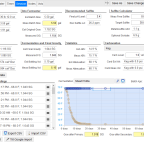 A short overview of using the session tab to record session specific measurements and fermentation data for your beer, mead, cider and wine recipes in BeerSmith Web. These features are also on the desktop version and the web version can be run from your tablet or phone. Related Videos: : Design Tab | Yeast Starter […]
A short overview of using the session tab to record session specific measurements and fermentation data for your beer, mead, cider and wine recipes in BeerSmith Web. These features are also on the desktop version and the web version can be run from your tablet or phone. Related Videos: : Design Tab | Yeast Starter […] Seven Latino men gathered on a Hacienda Heights driveway on a warm Southern California night. Shiny homebrewing equipment filled the garage so the fledgling craft brewers stood in the car port—pint glasses in hand—sharing names, hometowns and brewing experiences. The SoCal Cerveceros homebrew club was born. “We didn’t really know what it was going to […]
The post SoCal Cerveceros, America’s Largest Latino-Based Homebrew Club, Is Making Its Mark appeared first on CraftBeer.com.
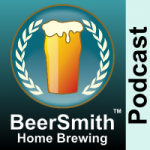 John Palmer joins me this week to discuss adjusting your water for beer brewing including mash pH and also improving the flavor of your beer. Subscribe on iTunes to Audio version or Video version or Spotify or Google Play Download the MP3 File– Right Click and Save As to download this mp3 file. Your browser […]
John Palmer joins me this week to discuss adjusting your water for beer brewing including mash pH and also improving the flavor of your beer. Subscribe on iTunes to Audio version or Video version or Spotify or Google Play Download the MP3 File– Right Click and Save As to download this mp3 file. Your browser […] Yakima Chief’s all-new Cryo Pop blend to be available through Cryer Malt by July.
The post ‘Revolutionary’ hop product coming Down Under appeared first on Beer & Brewer.
 This week I wanted to share a more detailed look at the upcoming Web based version of BeerSmith which is scheduled for release in June of 2021. It will be available to all Gold+ license holders of BeerSmith 3. When released, you can simply log into your existing BeerSmithRecipes.com account and edit recipes in your […]
This week I wanted to share a more detailed look at the upcoming Web based version of BeerSmith which is scheduled for release in June of 2021. It will be available to all Gold+ license holders of BeerSmith 3. When released, you can simply log into your existing BeerSmithRecipes.com account and edit recipes in your […] Building of 200 hectolitre brewery and visitor’s centre slated to take two years.
The post Stone & Wood’s ‘landmark day’ as $50m brewery confirmed appeared first on Beer & Brewer.
AWOL is their fourth venue and the second to open in the last six months.
The post Black Hops launch their barrel-aged beer taproom appeared first on Beer & Brewer.
A brewery and a winery have found validation in harnessing smoke tainted grapes.
The post Tainted love: Beers give smoky grapes a bright side appeared first on Beer & Brewer.
Big brother to core range IPL remains true to style despite tweaks to the recipe.
The post Beerfarm double down on original IPL appeared first on Beer & Brewer.
Melbourne farmhouse brewery Future Mountain celebrate their second birthday.
The post ‘Maybe we’re not so niche as we think we are’ appeared first on Beer & Brewer.
 This week I take a look at one of Germany’s most popular beer styles, the light lager known as German Helles. Helles is a traditional German Lager produced primarily in Southern Germany (Bavaria) around Munich. The word “hell” in German can be roughly translated as “pale, light or bright” in English. The History of Helles […]
This week I take a look at one of Germany’s most popular beer styles, the light lager known as German Helles. Helles is a traditional German Lager produced primarily in Southern Germany (Bavaria) around Munich. The word “hell” in German can be roughly translated as “pale, light or bright” in English. The History of Helles […] Why the Adelaide brewery’s portfolio of products has evolved as they’ve grown.
The post The Little Bang theory of brewery evolution appeared first on Beer & Brewer.
We look at all four of the Into the ‘Wood 2020 releases.
The post Stomping Ground’s Into the ‘Wood – a year in review appeared first on Beer & Brewer.
 This week I’m going to cover the new Tilt import features added in BeerSmith 3.1, as well as general features for importing and exporting CSV fermentation data from other sources. Tilt Data Import The Tilt wireless hydrometer has become a popular tool for home brewers. One of the top features many brewers asked for was […]
This week I’m going to cover the new Tilt import features added in BeerSmith 3.1, as well as general features for importing and exporting CSV fermentation data from other sources. Tilt Data Import The Tilt wireless hydrometer has become a popular tool for home brewers. One of the top features many brewers asked for was […]  I’m happy to announce the official release of the BeerSmith 3.1 update. This update includes some significant updates to the BeerSmith data storage model, TILT data import, new brewing features and a large number of bug fixes. This release is also a very important foundational step towards establishing both an online version of BeerSmith and […]
I’m happy to announce the official release of the BeerSmith 3.1 update. This update includes some significant updates to the BeerSmith data storage model, TILT data import, new brewing features and a large number of bug fixes. This release is also a very important foundational step towards establishing both an online version of BeerSmith and […]  Steve Piatz, the author of “The Complete Guide to Making Mead” joins me this week to discuss mead making techniques. Subscribe on iTunes to Audio version or Video version or Spotify or Google Play Download the MP3 File– Right Click and Save As to download this mp3 file. Your browser does not support the audio […]
Steve Piatz, the author of “The Complete Guide to Making Mead” joins me this week to discuss mead making techniques. Subscribe on iTunes to Audio version or Video version or Spotify or Google Play Download the MP3 File– Right Click and Save As to download this mp3 file. Your browser does not support the audio […]  Dr Charlie Bamforth, Professor Emeritus from the University of California at Davis joins me this week to discuss beer brewing yeast. Subscribe on iTunes to Audio version or Video version or on Google Play Download the MP3 File– Right Click and Save As to download this mp3 file. Your browser does not support the audio […]
Dr Charlie Bamforth, Professor Emeritus from the University of California at Davis joins me this week to discuss beer brewing yeast. Subscribe on iTunes to Audio version or Video version or on Google Play Download the MP3 File– Right Click and Save As to download this mp3 file. Your browser does not support the audio […]  Ted Fleming joins me this week from Partake Brewing to discuss how to brew alcohol free beer at home. Subscribe on iTunes to Audio version or Video version or on Google Play Download the MP3 File– Right Click and Save As to download this mp3 file. Your browser does not support the audio element. Topics […]
Ted Fleming joins me this week from Partake Brewing to discuss how to brew alcohol free beer at home. Subscribe on iTunes to Audio version or Video version or on Google Play Download the MP3 File– Right Click and Save As to download this mp3 file. Your browser does not support the audio element. Topics […] Smell – Aroma is light, doughy-grain, lightly citrus and roasted pear. An odd note of cinnamon as well.
Appearance – Clear pale yellow. It’s almost so pale that yellow isn’t the right word, it looks washed out, faded. Retention isn’t great, but the tight, white head sticks around for much longer than the other half of the batch.
Taste – Bright acid without being obnoxious. The finish has an odd fall-spice note as in the nose that I suspect is from the sumac. Dry without being a desert.
Mouthfeel – Classic Berliner, light and spritzy.
Drinkability & Notes – The not-entirely-pleasant musty-herbal flavor the dried sumac provided when the beer was young seems to have mostly faded to a light spiciness. I’m not sure I’d even pick it out if I didn’t know it was in there.
Changes for Next Time – Maybe a different/fresher source of dried sumac would provide a better flavor and aroma?
Staghorn Sumac Berliner
Smell – Aroma has the generic fruitiness of Hawaiian Punch, or Hi-C, but with an herbal hint of a Ricola cough drop. I don’t get any of the base beer, at this elevated rate it is all sumac. Certainly in the same sort of flavor-family as hibiscus.
Appearance – To go along with the aroma, it has the color of Hawaiian Punch. Similar head retention too…
Taste – The same fruit flavor from the nose, but more pronounced cherry candy. It’s a really fun flavor, that doesn’t stray into cloying. Acidity is snappy, sort of Vitamin-C, quick and punchy. No sweetness, finally breaks the comparison to "fruit" beverages.
Mouthfeel – Light, medium+ carbonation, but not excessively thin or harsh.
Drinkability & Notes – Staghorn sumac is a foraged ingredient that has a real chance for broader appeal. The flavor is fun, quenching, and somewhat familiar. The color certainly doesn’t hurt either. With how much it took, a mild base beer like this makes the most sense.
Changes for Next Time – I was sort of hoping this one wouldn’t be delicious so that I didn’t have to source a couple hundred pounds to put into a beer next summer. Likely could drop down closer to .5 lbs/gallon for a more balanced beer, but it is delicious as is!
I'll be making the trip down to Asheville, NC March 22-23 for another round of BYO Boot Camps! As usual I'll be talking about Wood/Barrels one day and Sour Beers the other. I said it before, but this really is looking like the last one of these for me given how much time running a brewery takes!
I was sad to see the tree go, but glad I got to brew a beer with acorns foraged from it before it went!
I inspected each acorn to remove any that were cracked, or otherwise marred. I briefly rinsed them, and then arranged in a single layer on a shallow baking dish in the basement to allow them to dry.
When I visited Scratch Brewing last November (on my drive from St. Louis to Indianapolis for the BYO Boot Camp... next one is March in Asheville) I had the chance to assist Marika on a batch at Scratch, and see their jars of fermenting acorns. Luckily for them, Aaron told me weevils haven't been an issue!
I'm hoping to use the remaining fermented acorns in a small batch at Sapwood Cellars, but the TTB isn't going along with my plans... yet. They've directed me to contact the FDA. It's amazing how many weird chemicals are approved, when a food that people have eaten for thousands of years is not.
Requiem for an Oak
Smell – Even at the higher rate the acorn character doesn’t leap out of the glass. It does have a richer, more woody-fruity aroma than any other quick sour I’ve brewed. I get some of that old book smell mingling with the Munich maltiness. There is also a brighter stonefruit aroma that prevents it from being too heavy.
Appearance – Pretty amber-brown color. Mild haze. Retention of the tan head is OK especially for a sour beer, although nothing remarkable.
Taste – Firm lactic acid, snappy without being overwhelming. The fermented acorns add leathery and fruity depth to the flavor without stepping all over the malt. I’m pretty happy with this as a lower alcohol oud bruin.
Mouthfeel – The flaked rye really helped considering this is a low alcohol sour beer. Doesn’t taste thin or watery.
Drinkability & Notes – For such a unique beer, it is pleasant to drink. The flavors meld nicely and the acorns help to simulate in a way the effect of barrel aging and Brettanomyces.
Changes for Next Time – I’d probably go even more aggressive with the acorn-rate, really to show them off. The beer could be bigger, but more malt might obscure the acorns even more.
Batch Size: 11.00 gal
SRM: 18.0
IBU: 2.0
OG: 1.046
FG: 1.010
ABV: 4.7%
Final pH: 3.43
Brewhouse Efficiency: 72%
Boil Time: 90 mins
Fermentables
-----------------
60.4% - 16.00 lb Briess Pilsen Malt
22.6% - 6.00 lb Weyermann Munich I
11.3% - 3.00 lb Flaked Rye
3.8% - 1.00 lb Castle Special B
1.9% - 0.50 lb Weyermann Carafa Special II
Mash
-------
Mash In - 45 min @ 157F
Hops
-------
1.25 oz - 8 Year Old Willamette (Whole Cone, 1.00 % AA) @ 85 minutes
Water
--------
11 g Calcium Chloride @ Mash
Calcium | Chloride | Sulfate | Sodium | Magnesium | Carbonate |
100 | 110 | 50 | 15 | 10 | 90 |
Other
-------
1 Whirlfloc Tablet @ 5 mins
2 Cup Fermented Acorns @ Fermenter
Yeast
-------
East Coast Yeast Flemish Ale
East Coast Yeast Oud Brune
Notes
-------
9/29/17 Harvested five pints of acorns from the White Oak in my front yard. Allowed to dry open in the basement.
10/6/17 4 larvae of an acorn weevil hatched. Tossed any acorns with exit holes, and tried to identify all of those with small entry holes to toss. Moved remaining acorns to one-pint mason jars, attached lids, and returned to the barrel room for fermentation.
Brewed 7/9/18
7/29/18 Added 1 cup of acorns (split and in a mesh tube with marbles) to the Oud Bruin half.
8/18/18 Added another cup of acorns, loose, as the flavor wasn't there yet.
8/28/18 Racked Flemish half to secondary in glass.
9/9/18 Kegged acorn half.
It seemed like a good time to revisit this batch because the scaled-up version went into barrels on Saturday. For the 10 bbl batch we used 58W3 for primary fermentation in stainless steel. We procured three Pinot Noir barrels plus two bourbon barrels for aging. My hope is that the spirit barrels provide a nice vanilla character to mingle with the cherries. Each will get a dose of microbes, East Coast Yeast Flemish Ale, Wyeast Roeseleare, and maybe additional microbes from our collection. Two of the barrels got 25 lbs of dried sour cherries. Next summer, when fresh sour cherries are available, we'll select barrels and blend into a tote for additional fruiting.
Wine Yeast Sour Red
Smell – Spice, caramel, apple sauce. A weird mix that doesn’t really remind me of a Flemish red. That wouldn’t be a bad thing if the flavors were enticing or synergistic.
Appearance – Pretty thick head. Nice reddish-brown color with abundant chill haze (judging from the clarity of warmer pour previously). Pretty beer at least!
Taste – Interesting spice notes as in the nose. Cinnamon especially. The fruitiness reminds me of quince paste, sort of apple, but not quite. Tart, but not really sour. The malt is one-dimensional, toasty. Not impressed by Roeselare as the sole source of microbes.
Mouthfeel – Thin, a bit watery despite finishing at 1.016. Solid medium-carbonation.
Drinkability & Notes – A real meh beer. Not off in any specific way, there just isn’t anything to carry the beer.
Changes for Next Time – For the scaled-up version, we swapped the Briess base malts for equivalent Castle malts. Other than the variety of microbes and barrels, we'll be sticking pretty close to the script for the cherry version.
My homebrewing-rate has slowed dramatically the last couple months, not coincidentally we brewed our first batch at the brewery around that time (House Saison brew day). Part of that is brewing 10 bbls about twice a week, the rest is how much time I spend at the brewery doing other stuff. My plan for The Mad Fermentationist is to keep up the same style of post, with recipes and tasting notes for occasional Sapwood Cellars beers. I'll still document homebrew batches when I can, mostly test batches or experiments with impractically weird ingredients.
The first beer I wanted to cover is my favorite of the initial four clean batches, Rings of Light. For those interested the name, is a subtle The Fellowship of the Rings reference: "They watched the pale rings of light round his lanterns as they dwindled into the foggy night." It is exactly the sort of beer I love drinking, moderate alcohol (4.8% ABV), but with a huge hop flavor and aroma and a surprisingly luscious mouthfeel. Luckily Untappd reviews have been pretty positive, and it is our tasting room's top seller so far!
You'll likely recognize most of the elements of the recipe as things Scott and I have been doing for years. Golden Naked Oats, Chit malt, Boddington's yeast (RVA Manchester), moderate-high chloride and sulfate, less expensive hops in the boil (Cascade and Columbus), and Citra dry-hopping. We added mid-late fermentation additions to several of our other batches, but this one was soft-crashed to 58F before dry hopping so we could harvest the yeast for re-pitching into an IPA (Cheater Hops) and DIPA (Uncontrollable Laughter).
The process tweaks have mostly been to account for the differences related to the physics of working at scale. For example, usually I'd add a small dose of hops at 15 minutes to up the bitterness, but in this case the extended contact after flame-out makes that unnecessary (between whirlpool, settling, and run-off near-boiling wort is in contact with hops for more than a hour). In fact, we added one barrel of cold water at flame-out to lower the whirlpool temperature to reduce isomerization. Beersmith 3 includes the capability to specify the average temperature of the wort during the whirlpool, still the estimate seems to be wildly higher than the perceived bitterness. I wonder if the hops settling, mixing with the proteins in the trub-cone slows the isomerization rate?
It has taken a little time to dial in our Forgeworks brew house. We achieved slightly lower efficiency and attenuation on this batch than expected for example. We've made a few mistakes and miscalculations along the way, but given neither of us had brewed frequently at a commercial scale I'm happy to report that things have been relatively smooth. Our biggest issues have been with the durability of the equipment itself. For example the rakes in the mash tun detached from the motor twice, and our burner shorted after a boil-over. What is taking the most effort to optimize is our cleaning and sanitation regimen.
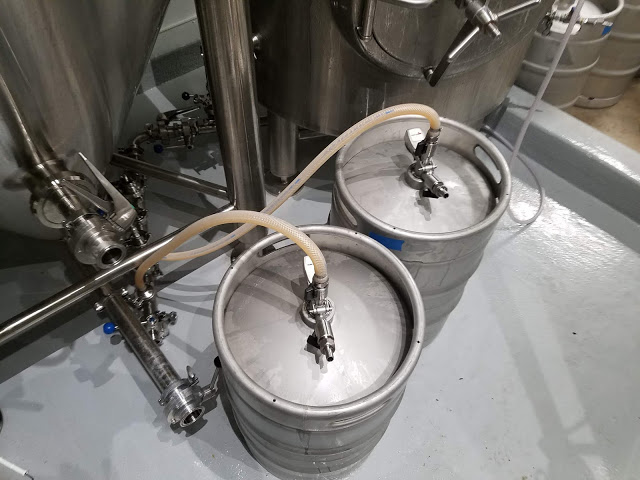
Thanks to everyone who came out to our grand opening last weekend! I didn't expect as many fans of the blog to drive from an hour or more away to try the beers and say hello. Either Scott or I will be there most of the time we're open, so let us know! Happy to show you around and talk brewing. For those further away, I'm also running the brewery's Twitter and Facebook accounts for now (Scott took Instagram because I couldn't figure it out).
Rings of Light
Smell – Pleasantly mango-melon hop aroma. As it approaches room temperature I get a slightly toasty-vanilla-richness thanks to the yeast playing off the Golden Naked Oats. Otherwise a pretty clean/fresh aroma.
Appearance – Pleasantly hazy yellow, glowing in the right lighting. I guess we did an adequate job avoiding oxygen pickup during transfers and kegging as it hasn’t darkened! We certainly pulled some hop matter into the bright tank, but it mostly settled out and stayed behind when we kegged, as I don’t see any particulate in the pour. Head is really thick, but could have better retention.
Taste – I really love the flavor on this, really saturated with juicy hops. Similar to the aroma, the tropical flavors from the Citra dominate the Cascade and Columbus. We were surprised how hop-forward it was even before dry hopping (perhaps thanks to the deep kettle slowing the evaporation of the oils?). Bitterness is pleasant, but restrained. Well below the estimated 70+ IBUs, more like 40-50 to my palate.
Mouthfeel – Full bodied, especially for a sub-5% beer. That is thanks to the oats, and low attenuation (which allowed for more malt for the given alcohol). As usually the substantial texture of the head from the chit malt really enhances the perception of creaminess.
Drinkability & Notes – Glad this beer ended up as an early-fall release. It is a little full for a quenching summer pale ale, but it is perfect for temperate weather. The hops are well balanced, and provide enough interest to demand each additional sip. The malt mostly stays hidden, while providing adequate support.
Changes for Next Time – We’ve already got a new batch of this fermenting with the same grist and kettle-hops, although given the tweaks (higher original gravity and different yeast: Lallemand New England and S-04) it may receive a different name.
Recipe
Batch Size: 315.00 gal
SRM: 4.9
IBU: 73.7
OG: 1.052
FG: 1.018
ABV: 4.8%
Final pH: 4.54
Brewhouse Efficiency: 68%
Boil Time: 60 Mins
Fermentables
-----------------
75% - 495 lbs Rahr 2-Row Brewer's Malt
16.7% - 110 lbs Simpsons Golden Naked Oats
8.3% - 55 lbs Best Chit Malt
Mash
-------
Mash In - 60 min @ 153F
Hops
-------
11 lbs Cascade (Pellets, 7.20% AA) - Steep/Whirlpool 75.0 min
11 lbs Columbus (Pellets, 15.70% AA) - Steep/Whirlpool 75.0 min
22 lbs Citra (Pellets, 12.00% AA) - Dry Hop Day 10
Other
-------
40 g Whirlfloc G @ 15 mins
Water
-------
200 ml Phosphoric Acid 75% @ Mash
1.00 lb Calcium Chloride @ Mash
0.70 lb Gypsum (Calcium Sulfate) @ Mash
50 ml Phosphoric Acid 75% @ Sparge
Calcium | Chloride | Sulfate | Sodium | Magnesium | Carbonate |
120 | 150 | 100 | 20 | 5 | 100 |
Yeast
-------
RVA Manchester Ale #132
Notes
-------
Brewed 8/29/18
Collected 315 gallons of water.
All salts and 100 ml acid right after mash-in. Ran rakes for 15 minutes, started recirculation 10 minutes after mash in. After 10 min of recirculation, measured temp at 152.8F.
Measured mash pH at 5.42, add 50 mL more acid. 5.39, add 50 mL more acid. 5.34.
Sparge water 183F, pH 6.47 with acid addition - more next time
Start of boil with 11 bbls of 1.055 runnings.
Added 1 bbl of cold water at the start of the whirlpool. Combined temperature 196F, added hops.
Run-off started at 66F. .5L/min of O2 through in-line stone.
Ended up with a wort temperature of 64F. Set tank to to 66F. By the next morning the glycol chiller had popped the breaker and the tank was at 69F... Reset and lowered to 67F.
8/31 Raised set-point to 69F to ensure finish.
9/3 Fermentation appears nearly complete from lack of CO2 production. Tastes good, better hop aroma than expected. Up to 70F to ensure it is done before soft crashing.
9/6 Harvested yeast. Left blow-off open so no dissolved CO2.
9/7 Dry hopped with 22 lbs of Citra through the top port while running 25 PSI of CO2 and blow-off arm closed. Closed everything and add 5 PSI as head pressure.
9/8 Pushed 15 PSI through racking arm for 1 minute to rouse, 18 hours after dry hopping. Dropped temperature to 54F.
9/9 Pushed 15 PSI through racking arm for 1 minute. Dropped temperature to 50F.
9/10 Crashed to 36F.
9/12 Moved to bright tank. 3 L/min of CO2 set to 16 PSI got to ~11 PSI at 36 F. 2.6 volumes of CO2 prior to kegging.
9/15 Kegged, 17 kegs with the last almost full.
I get a commission if you buy something after clicking the links to MoreBeer/Amazon/Adventures in Homebrewing/Great Fermentations!
I have nothing against brewing to-style. You can make magnificent and delicious beers by using ingredients from a single region with the goal of a classic balance. That isn't who I am as a brewer though. The recipe for Sapwood Cellars' False Dragon is the sort that I'm passionate about. We selected ingredients from all over the globe to create a flavors and aromas that aren't authentic to any one tradition. What I wanted was an earthy-crisp malt flavor, a white-winey hop aroma (for less money than Nelson Sauvin), and a subtle spicy and fruity-boost from the yeast without getting in the way. That required malts from America and England, hops from America and Germany, and yeast from England and Belgium.
I'd been experimenting with the hop bill for a few months to get the ratio right, and eventually settled on 2:1 in favor of Mosaic. After a few test batches, Scott and I have embraced adding less expensive hops on the hot-side (Cascade, Columbus, Chinook, Centennial etc.) with the more aromatic and expensive varieties saved for the fermentor. I wanted to split my homebrewed test batch to compare S-04 alone against S-04 with 8% T-58. As with Ziparillo, dry yeast is cost-effective especially if you can't repitch thanks to early or mid-fermentation dry hopping. Belgian strains have shown heightened biotranformation abilities is some studies, so it seemed like a good candidate for double dry-hopping.
For the 10 bbl batch we decided to fill-in a gap in our range when the first batch of Rings of Light (our Citra dry-hopped hazy pale ale) came in under-alcohol at 4.8% thanks to lower-than-expected efficiency. In effect the two recipes switched places with False Dragon becoming the "bigger" pale ale at 5.3% rather than the 4.7% of the test batch. Our attenuation has been lower than expected across the board for our first five batches too. We're still trying to figure out the cause given it has happened with multiple yeast strains - likely mash related. Luckily our hop flavor and aroma have both been wildly better than either Scott or I have been able to achieve at home, I'm sure surface-to-volume ratio plays a role.
Your first chance to try this beer is at the Sapwood Cellars grand opening, Noon-10 PM on Saturday 9/29. We'll be open Thursday-Friday 4-10 PM and Saturdays Noon-10 PM from then on. Stop in, drink a beer, say hello!
The name False Dragon come from The Wheel of Time series of books by Robert Jordan. My commute has gone from 20 minutes on the subway to my desk job to ~40 minutes by car. Audio books are my new friend. While I'm sure brewing podcasts would be a more productive use of my time, after 12 hours brewing it is nice to have a little escapism.
False Dragon S-04
Smell – Had to go for a fresh pour after taking photos as it had gone a hint skunky after five minutes in the sun… Nose is a fresh “true” hop aroma to the Mosaic and Hallertau Blanc. White wine, but also some blueberry and green/herbaceous. Certainly Nelson-reminiscent, but a unique character as well.
Appearance – Pale yellow, pleasantly hazy. Good head and lacing, but the foam itself feels airy on the tongue. I guess I’ve gotten used (and miss) to the contribution of chit malt.
Taste – A firm amount of bitterness in the finish, but it doesn’t linger. Light and bright with the tropical-fruity hops starring. Rye doesn’t really make a strong showing, although I’ve always found it more subtle than some others taste.
Mouthfeel – The rye helps prevent it from being watery, but it is a summery pale ale. Glad we ended up a little higher OG/FG on the big batch. Medium carbonation, nice for a lighter beer.
Drinkability & Notes – A pleasant session IPA. The Mosaic and Hallertau Blanc work better together than apart.
Changes for Next Time – 10% chit in place of the base malt wouldn’t hurt. Could certainly up the rye too for a bigger contribution.
S-04 and T-58
Smell – More rounded, less grassy-distinct hop aroma. Tropical, juicy, inviting. The green flavors are now more honeydew melon. Impossible to say how much of that is actual hop chemical reaction, or synergistic between the hops and esters. Lightly bready.
Appearance – Looks similar in terms of head, color, and clarity.
Taste – Lower perceived bitterness. A more saturated/integrated fruity hop flavor. Passionfruit especially. I think this is the more approachable and interesting beer, and distinct from the other English-only fermentation we are doing (using RVA Manchester). Slightly elevated phenols, but much lower than from the WB-06 in Ziparillo.
Mouthfeel – Slightly creamier (perhaps just the lower perceived bitterness?), identical carbonation.
Drinkability & Notes – I was able to identify these pretty easily in a blind tasting. It is amazing how much impact such a small amount of yeast can make.
Changes for Next Time – We decided to back down the T-58 4.4% of the blend to allow a bit more of that fresh/distinct hop character through. Other than the higher gravity, the recipe was otherwise unchanged for the 315 gallon batch! We’ll probably up the rye for batch #2 now that we know we can handle higher percentages of high beta-glucan huskless grains.
False Dragon - Test Batch
Batch Size: 11.00 gal
SRM: 4.1
IBU: 30.0
OG: 1.046
FG: 1.012/1.012
ABV: 4.7%
Final pH: 4.43/4.49
Brewhouse Efficiency: 72%
Boil Time: 60 mins
Fermentables
-----------------
75.6% - 17 lbs Rahr 2-Row Brewer's Malt
14.4% - 3.25 lbs Briess Rye Malt
10.0 % - 2.25 lbs Crisp Floor Malted Maris Otter
Mash
-------
Mash In - 45 min @ 156F
Hops
-------
8.00 oz Centennial (Pellet, 7.20%) @ 30 min Steep/Whirlpool
6.00 oz Mosaic (Pellet, 12.25%) @ Dry Hop Day 3
3.00 oz Hallertau Blanc (Pellet, 10.50%) @ Dry Hop Day 3
6.00 oz Mosaic (Pellet, 12.25%) @ Dry Hop Day 7
3.00 oz Hallertau Blanc (Pellet, 10.50%) @ Dry Hop Day 7
Other
-------
1 Whirlfloc Tablet @ 5 mins
Water
-------
18 g Calcium Chloride
12 g Gypsum (Calcium Sulfate)
6 tsp Phosphoric Acid 10%
Calcium | Chloride | Sulfate | Sodium | Magnesium | Carbonate |
150 | 150 | 150 | 15 | 10 | 90 |
Yeast
-------
11.5 g SafAle S-04 English Ale
or
11.5 g SafAle S-04 English Ale
1 g SafBrew T-58 Specialty Ale
Notes
-------
Brewed 8/19/18
Mash pH = 5.44 (at mash temp) after acid additions.
Collected 14.5 gallons of 1.046 runnings.
Added heat to maintain a whirlpool temperature of 200F.
Chilled to 64F. Half with 1 g of T-58 and 11 g of S-04, and half with only 11 g of S-04. Left at 62F ambient to begin fermentation after shaking to aerate.
69F internal temperature during peak fermentation.
8/22 Dry hopped each with 3 oz of Mosaic and 1.5 oz of Hallertau Blanc.
8/27 Second dry hop for both.
9/1 Kegged both, 1.012, moved to fridge to chill.
9/2 Hooked up to gas and tapped to remove sludge. S-04 batch clogged poppet a few times.
I get a commission if you buy something after clicking the links to MoreBeer/Amazon/Adventures in Homebrewing/Great Fermentations!
It is tempting to say that beer isn’t like that. After all, each all-grain batch starts with the four basic ingredients and we do the rest… sure it would be a challenge to grow and malt barley, harvest and dry hops, isolate/propagate wild yeast, and haul water from a local stream, but what vessels would you use to boil/ferment? What about sanitizer, minerals, clarifiers, compressed CO2?
What follows is a high-level overview of what is required to brew a single batch of beer at Sapwood Cellars. Obviously, you could keep digging deeper into each one of these, peeling back layer-after-layer to the inputs of each input (e.g., the shoes that the hop harvester was wearing). I’ll arbitrarily stop where I lose interest. Needless to say though, the work of thousands in not millions of people goes into each of our batches. Scott and I just get the credit (or blame) because we're the ones at the end of the chain!
Ingredients
Water
Our water comes from Liberty Reservoir. From there it goes to Baltimore’s Ashburton water treatment plant. Baltibrew posted a nice series on the Baltimore water system. Luckily for us the existing minerals are mostly beneficial to the character of our beer. The carbonate is a bit higher than we’d like, but not by enough to require the waste of reverse osmosis.
Once pipes take it to the brewery it passes through a carbon filter to remove chlorine, and then an on-demand hot water heater. The fuel is natural gas piped into the brewery by BG&E (by way of fracking or older methods, and then refining). From there the water travels through a hose to our hot liquor tank where an electric element allows us to adjust the temperature. The electricity comes from a mix of fossil fuels, nuclear, and ~5% renewables.
To adjust the mineral content of the water, we add calcium chloride (from limestone-hydrochloric acid reaction or natural brine concentration) and calcium sulfate (harvested and refined from gypsum rock deposits). In addition, we add 75% phosphoric acid to adjust the pH of the water. Phosphoric acid is usually produced by combustion, hydration, and demisted from three ingredients: phosphorus, air, and water.
Grains
The grain we mash is a mixture of barley, wheat, oats, and rye depending on the beer. These are grown primarily on farms in North America and Europe. It is then soaked, sprouted, dried, and kilned by a maltster. The precise equipment required varies by malt and producer. In some cases it is a large industrial operation, in others the malt is still manually turned. The bulk of our base malt is Rahr brewer’s 2-row from Minnesota, but in our first order we also had sacks from Briess, Chateau, Simpsons, Crisp, Best etc. Most of the unmalted flaked grains (steamed and rolled to gelatinize their starches) are from Grain Millers.
We decided to hold-off on buying our own mill, to save the cost at the start… but after a few brews I can say a mill and auger are in our near future. We order our grains from Brewers Supply Group, which pre-mills the grain. We also occasionally add a few sacks to a Maryland Homebrew order from Country Malt.
Once we’re done with the now “spent” grain, they are picked-up by Keith of Porch View Farms. He feeds it to his animals as most of the carbohydrates are extracted into the wort, but proteins remain.
Hops
Our hops are grown throughout the higher latitudes of the globe, primarily the Pacific Northwest of the United States, but also Australia, Germany, and Czech Republic. The hops are first stripped from their bines, dried in an oast, and then baled. After selection, various lots are blended to create a consistent product and the hops are pulverized and pelletized. They are then vacuum-packed in mylar and stored cold to preserve their aromatics. Our hops primarily came from Hop Havoc, but we’re working on getting contracts for the upcoming harvest.
Yeast
Most of the yeast we’re using are the decedents of yeast that have been fermenting beer for hundreds or thousands of years. A couple hundred years ago their ancestors were part of a mixed-culture at breweries in England and Belgium, only to be lucky (and talented) enough to be isolated as a pure culture that gained success. Our Saccharomyces cerevisiae so far has come from RVA, Fermentis, and Lallemand for our “clean” beers. These needed to be isolated, propagated, and in some cases dried.
The sour and wild beers are too complex to track. They come from labs, bottle dregs, and a house culture. They may have come via a barrel, the breeze, an insect, or any number of other vectors into a brewery or labs. For example the Hanseniaspora vineae we are fermenting a hoppy sour for Denizen's Make It Funky festival came from Wild Pitch Yeast which isolated it from tree bark.
Fruit
We don’t have any beers far enough along for fruit, but we’re planning to source as much of it as we can directly from local farms and orchards. Most fruit is at its best when it is picked ripe and used quickly. I'm sure we'll use dried fruit, aseptic purees, juices, and freeze-dried fruits depending on quality, availability, and desired results as well. The first batch will probably be a tart saison on grape pumace (the pressed skins) from a local natural winery.
Other Consumables
Gas
Carbon dioxide is usually produced as a byproduct of some other activity (e.g., hydrocarbon processing). Our CO2 is stored in a 750 lb tank in a liquid state. We use it to carbonate and serve beer. It isn't economical at our scale to recapture the CO2 released by fermentation. Our supplier is Robert’s Oxygen.
As the air on Earth is 70% nitrogen it is usually concentrated with the use of a nitrogen generator. These rely on a membrane that allows nitrogen through. We need nitrogen to help push the beer through the long-lines from our walk-in to the tasting room (pure CO2 would lead to over-carbonation at those pressures). As the second most abundant gas in the atmosphere, oxygen generation uses similar technologies. We pump .5L/minute into the wort as it exits the heat exchanger, the yeast quickly uses it to create sterols for healthy cell walls when they bud. We get these two gases in large cylinders that are swapped out.
Chemicals
We need cleaners like caustic (sodium hydroxide) to remove organic deposits, and a phosphoric-nitric acid blend to remove inorganic beer stone and passivate the stainless steel. For sanitation we use iodophor for fittings in buckets, and peracetic acid for the tanks. These are made in a variety of industrial processes that I’m totally unaware of. Our chemicals are provided by Zep/AFCO.
Clarifier
Whirlfloc G helps proteins clump together in the last 15 minutes of the boil to be left behind. It is derived from Irish moss (seaweed) that is dried and granulated. As a vegan brewery, no gelatin or isinglass for us.
Barrels
Oak barrels start as oak trees. They are processed into planks, and then purchased by a cooperage which dries (either in a kiln or naturally). They are then assembled into barrels with metal hops, toasted, and sealed. From there they go to vineyards and distilleries that age their products in them. Beer is best in barrels that have already lost much of their oak character, so we buy them from other producers. A small amount of the wine or spirit is still present in the wood, providing a moderate contribution to the first batch, diminishing with each additional batch.
Equipment
The stainless steal for the vast majority of our equipment comes from China. Our brewhouse was constructed by Forgeworks in Colorado. Our fermentors and bright tank from Apex and DME in China. Our keg washer from Colorado Brewing.
The cooling of the fermentors is accomplished by a glycol chiller from G&D Chillers in Oregon. The ethylene glycol itself comes from ethylene and oxygen. The chiller also assists chilling the wort with our two-stage Thermaline heat exchanger (primarily more stainless steel). The copper pipes that carry the glycol are insulated with Armaflex. The flow of the glycol to individual tanks is controlled by electronic temperature sensors and solenoid valves.
Other equipment includes hydrometer, refractometer, pH meter, hoses, gaskets, and all manner of other valves and fittings.
For the space itself there was already plenty of concrete, bricks and metal. We hired Kolb Electric and B&B Pipefitters to do the installation of the bulk of the wires, pipes, and connections.
There is also everything that goes into serving a beer once it is ready. Kegs (Corny kegs for the sours and infusions, sanke for the standard clean beers), stainless steel fittings, beer lines, glasses (including the printed logo and the glasswasher) etc.
What’s the Point?
I don’t really have one. To me it is just remarkable how much of the complexity of brewing a batch of beer is now hidden in the inputs. I know how to brew beer at my house or a brewery, but if you put me out in the woods even with all the ingredients, I couldn’t brew a batch. Thinking about what is required for each batch makes me appreciate how nice it is to live in a time when I can brew beer as simply as going online and ordering the equipment and ingredients I want. It also shows me how much I still have to learn about making beer.
At the same time, it means that beers everywhere are mostly separated by the choices the brewer makes rather than the availability of ingredients. The exchange of information accelerated by the Internet. I hope there continue to be regional variations, specialties, and preferences. Traveling isn't as exciting when everyone brews NEIPA and pastry stouts.

